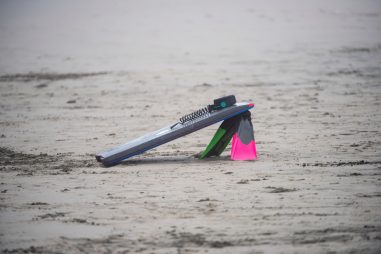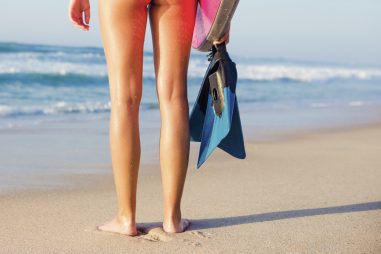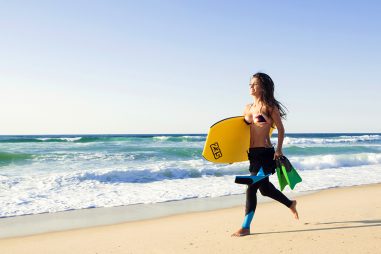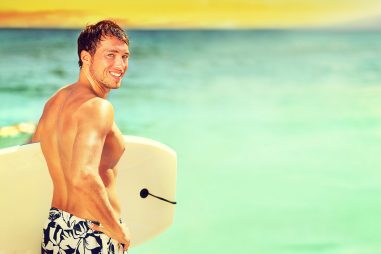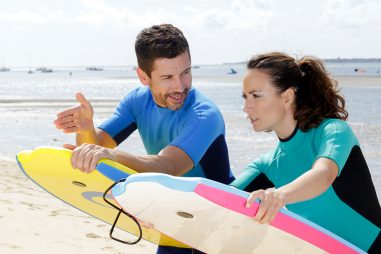Bodyboarding is one of the best watersports of our time. It’s not age-restricted, but you must have good swimming ability and fitness as you will be riding through the waves and should be comfortable enough to return to shore. Therefore, it’s a good idea to enroll in a bodyboard lesson to know the basics and safety essentials.
Is Bodyboarding Dead or Still Popular?
Bodyboarding remains popular as a recreational activity for families and casual bodyboarders in the United States. The sport is comparatively less expensive than other watersports, and it includes a wide age range, from kids as young as 4 to adults in their 70s. In addition, you can enjoy different waves in bodyboarding that you would not be able to do in surfing, making it an attractive sport.
Bodyboarding, however, is going through a crisis in terms of world competitions in the United States. World tours were on a halt due to the lack of funding. Thankfully, organizations such as the Association of Professional Bodyboarding (APB) are making arrangements to strengthen the foundations of the sport in the States and ultimately restore the world competitions to the home country of bodyboarding.
What Is the Meaning of Bodyboarding?
Bodyboarding is a watersport where you lie with your stomach flat on the board or kneel as you ride the crest and the curl of the waves. Compared to surfing, bodyboards don’t require the rider to stand on the board. Its high-end polypropylene and polyethylene foam make bodyboarding ride all types of waves that surfing won’t be able to.
Bodyboarding is commonly referred to as boogie boarding by many. It was due to the invention of the first boogie board back in 1971. The term boogie board is a trademark, while bodyboarding is the actual name of the sport.
What Do You Do With a Bodyboard?
The bodyboard will allow you to ride the waves with your belly flat on the board. You may use a fin to help you thrust forward. You paddle towards the tide, turn your board to the shore, and wait for a crest as it propels you back to the beach. You will eventually learn to read the waves and identify which wave will optimize your riding experience as you continuously practice.
Some advanced riders use the board while kneeling, enabling them to perform different tricks. Before getting on the water, make sure to wax your board first and put on the leash either on your left or right wrist. Don’t forget your wetsuit!
Is Bodyboarding Safe or Dangerous?
Bodyboarding is generally safe, making it one of the reasons why it remains an in-demand beach activity for various groups. You do have to note the following, though, to keep your bodyboarding experience more secure.
- Do not ride waves that do not match your skill level. For beginners, start with whitewater waves or small rollers.
- Be aware of where the waves will take you. Be wary of rocks, shallow areas, and people around you.
- Be knowledgeable of the surfer etiquette. It is most important, especially when there are other surfers or riders in the water.
- Do not allow kids to bodyboard without supervision. Don’t go by yourself alone.
- Invest in a bodyboard with a leash. The leash will keep you more secure and get your board within reach.
- Before leaving, always check the forecast for wind and tide.
- Look out for signs on the beach that identifies where rips and currents are.
- Enroll in a bodyboarding lesson. It will help you become more educated about the sport, maximize your practice, and be conscious of safety precautions.
- Watch out for signals from other bodyboarders to avoid the risk of injury or accident.
- Learn to swim. It is always best that you are capable of getting yourself back on the shore in any given circumstance.
Keep the above tips in mind to maintain a safe and fun experience while bodyboarding. Doing this will keep not just you protected but also your fellow riders and surfers around you.
Why Is Bodyboarding Dangerous?
Bodyboarding can be dangerous for beginners if they are not aware of its rules! First and foremost, you’ll have to choose the right board for you. Each bodyboard is different depending on your size and skill level. Not being equipped correctly can get you in danger. Going on waves beyond your experience and not being conscious of the potential hazards around you can cause an accident.
Bodyboarding can also be unsafe for everyone around if you don’t observe the surfer etiquette. Imagine the chaos if no one respected the right of way and just monopolized the waves or cut other surfers. Instead, be courteous and respectful of other surfers and riders, and use hand gestures to signal when you intend to ride a wave.
Is Bodyboarding a Sport?
Bodyboarding started in the United States and became a recognized sport around the world. During its early days, the United States has hosted numerous competitions: the International Morey Boogie Bodyboard Pro Championships, the GOB World Tour, IBA World Tour, and APB Tour.
Different countries around the world host the Bodyboarding World Championship every year. In the 2019 APB World Tour in South Africa, Tristan Roberts became champion.
Like other sports, there is also a Women’s Bodyboarding competition. In the championship held in Japan back in 2018, Ayaka Suzuki was hailed as the champion.
Is Bodyboarding an Extreme Sport?
Bodyboarding is a high-performing watersport and can be extreme. However, this sport takes on a different level because of the board’s versatility on the waves and the vast array of tricks you can perform. For instance, a few professional bodyboarders perform advanced tricks such as:
- Barrel: Riding a deep and heavy barreling wave. To barrel on a wave with your bodyboard is one of the best experiences any bodyboarders want to have.
- Backflips: Doing a reverse 360-degree curve at the top of the wave. Practicing a backflip on a trampoline can help with your practice.
- Air Roll Spin: this maneuver is a combination of El Rollo and Forward Spin. To perform this move, you’ll have to master the El Rollo first.
Once you have perfected the basics of bodyboarding, you can explore more challenging tricks gradually. Mastering beginner and intermediae tricks will get you prepared to execute advanced tricks.
How Did Bodyboarding Come About?
Back in 1969, on the coast of Doheny Beach Park in California, bodyboarding first came as an idea when Tom Morey saw a young rider with a homemade four-foot board and several four-inch-wide polyethylene logs (1.2 m board with 10 cm logs). Graduating as an engineer, he made his first bodyboard on his return to Hawaii in 1971.
Bodyboarding is also inspired by rubber mats or surf mats that were popular back in the 1960s. They were the classic inflatable surfboards back in the day but lost their fame when bodyboards became sought-after in the market.
Where Did Bodyboarding Come From?
Bodyboarding is an inspiration first observed by the Polynesians riding waves. Captain Cook once noted them drifting through waves on their belly, knee, and in rare circumstances, their feet during his expedition back in 1778. The board they used is called Alaia (pronounced as ah-lie-ah) board. Early riders made their boards with Acacia koa wood which varies in length and shape.
In the process, the boards evolved into Paipo (pronounced as pipe-oh), which was made either in fiberglass or wood. The fiberglass board had fins on the bottom. It is where the vision came from that led to the creation of the first bodyboard.
Who Invented Bodyboards?
In the middle of 1971, Tom Morey invented the first bodyboard. The first board was 23″ wide and 4’6″ long (59 cm x 137 cm), leaving the nose flat and weighing only 3 pounds (1.4 kg).
Made of polyethylene foam and covered with newspaper, he tested the board out in the Honels, a popular west side of the Big Island, and rode it around a knee-high surf. Then, realizing it could be a big thing, he moved to the Mainland and, in 1973, trademarked the name Morey Boogie.
Bodyboards were in such great demand that they sold more than 80,000 in the States alone. It then became a global phenomenon, with the first professional bodyboarding competition held in 1979 and the first world bodyboard championship competition in 1982 that continues until this day.
Who Invented Drop-Knee Bodyboarding?
The drop-knee bodyboarding stance is a revolutionary bodyboarding maneuver founded by Jack Lindholm in the late 1970s. Also called “Jack Stance,” this is done with your preferred fin forward on the front deck and your back knee on the bottom end of the board, letting the fin drag in the water. You then use your upper body and arms to steer the board.
The drop-knee stance requires a bodyboard with a rounded nose template and a crescent tail with a lower wide-point halfway down the board to allow the rider to put their weight on the back of the board. Riders highly rely on weight distribution to hold the line on a wave.
When Was Bodyboarding Invented?
The sport bodyboarding was invented in 1971 when Tom Morey created the first bodyboard. In 1973, Morey Boogie was founded and became the most well-known bodyboard-surfing company worldwide. They also hosted the first professional bodyboard competition in Carlsbad, California, in 1976.
It quickly became a global success, inviting bodyboarders from around the world to the World Tour Championships. The first bodyboard champion was Daniel Kaimi, who rode the Pipeline and became known as “The Boogieman.”
When Was the First Bodyboard Made?
The first bodyboard came to be on July 7, 1971. The name of the bodyboard was SNAKE (side, navel, arm, knee, elbow), but it was later changed and trademarked to the name Morey Boogie which led to the popular term boogie boarding.
He sold his first board for USD 15 to see if anyone would purchase it. By the end of 1971, he got a contract with G&S Surfboards and promoted his boards in surfing magazines marketing them for USD25.
Why Was Bodyboarding Invented?
Tom Morey invented bodyboarding because of an initial idea that he wanted to make a surfboard ultimately fast. He had just moved to Hawaii and felt the need to create something brand new, as he didn’t have any board to use to ride the waves.
Tom Morey is a surf enthusiast and an engineer that led him to invent surf-related innovations. He started with the first-ever Concave Nose Pocket back in 1954 and created the Wing Tip in 1955.
Why Does Hawaii Have a Bodyboard?
Tom Morey invented the first bodyboard prototype in Hawaii, the place where bodyboarding was born. Precisely in Kailua-Kona at Wai’aha, commonly referred to as Honels, named after the family that used to live there. When Morey sold his company, it became mass-produced and more available to the market, even in Hawaii.
Since Wai’aha is the home of bodyboarding, they organized an annual Malama Wai’aha Roots Bodyboard contest to honor the birthplace of modern bodyboarding. The competition started in 2002 and is continuous until this day.
Are There Professional Bodyboarders?
Yes, there are many professional bodyboarders. These professionals join the World Tour Championship held every year; and are given their ranking according to the points they received on each tour. Some professional bodyboarders include:
- Mike Stewart: Won 9 championships in the International Morey Boogie Bodyboard Professional Championships and is deemed the greatest competitive bodyboarder.
- Dave Hubbard: is the most successful bodyboarder in knee-drop competitions.
- Alexandra Rinder: is the highest-ranked female bodyboarder in the world.
- Guilherme Tâmega: is considered the best bodyboarder of all time, with six world titles.
- Jeff Hubbard: is known for his aerial maneuvers and for being one of the few who can land a 720-degree flip.
These are just a few names in the world of bodyboarding. There are more professional bodyboarders who rose to fame for their unique and highly regarded skills.
Who Is the Most Famous Bodyboarder?
The most famous bodyboarder is Mike Stewart. He is regarded as the father of modern bodyboarding, lauded as one of the best competitive wave riders of all time. He is one of the early pioneers of bodyboarding and is, therefore, the most experienced bodyboarder.
Born in 1973 in Hawaii, he was the only person named “Mister Pipeline” for being the best wave rider of any kind. Considered the tube riding expert, he invented new maneuvers and pushed the limits in bodyboarding.
Who Is the Best Bodyboarder in the World?
Guilherme Tâmega is considered the best bodyboarder in the world. He has won six world titles, three-time champion of the Shark Island Challenge, and two gold medals at the ISA World Bodyboarding games.
Born in 1972 in Brazil, and is considered one of the legends of bodyboarding. He was in the sport for more than two decades, with Mike Stewart as his rival. He recently announced his retirement and will be focused on growing his bodyboard brand.
How Much Money Do Bodyboarders Make?
Professional bodyboarders make US$ 200,000 to US$ 400,000 annually. The income will depend on the number of sponsorships you receive, revenue from your merchandise, the income you earn from social media and affiliated links, and the competition prize money.
Most bodyboarders rely highly on sponsorships. Before anything else, though, you must practice hours and train every day to win. Eventually getting your brand sponsorship and building your own product.
What Age Can Children Bodyboard?
Children as young as four years old can learn to bodyboard. Here are some tips that can help you when you teach your kids to do bodyboarding.
- Start with swimming lessons: Your child must first be comfortable enough in water before teaching bodyboarding.
- Try it at the beach: Go to the beach suitable for bodyboarding lessons. First, check the area where there won’t be a lot of people.
- Get a board: Get your children the perfect bodyboard according to their size and preference. Also, get a bodyboard with a leash to keep them extra protected.
- Invest in proper gear: Invest in a rashguard or a wetsuit for your kids. It will protect them from sunburn or cold temperatures.
- Learn the basics first: Teach the basics of paddling and catching the waves by first showing it to them, doing it with them, and letting them do it themselves.
- Start near the shore: Remain on the shallow part of the beach for easier access to the shore.
- Think safety first: Keep away from shore breaks to avoid a risk of injury.
- Slowly but surely: Refrain from pushing your kids into the lessons but allow them to learn it gradually.
- Feedback is important: Ask your kids about their experience and what they think about bodyboarding. Hearing their feedback will allow you to identify any discomfort, hesitation, or if they are having fun.
- Patience is key: Be patient and allow your children to enjoy the time they have in the water.
Your children will have one of the best memories once they learn bodyboarding. Be gentle with them and allow them to learn at their own pace. Once they do, you’ll have a bodyboard partner for life!
How Do You Use a Bodyboard for Kids?
Using a bodyboard for kids is similar to how you use a standard-size bodyboard. You will want to supervise your children the entire time to make sure they are safe. It’s best to start with water around waist-deep, making sure they are wearing their leashes. Show them how you ride the wave, do it with them, then let them ride the waves themselves, and repeat the process.
As established, the size of the board must be according to the height and weight of your children. A 33″-37″ (83–94 cm) bodyboard is a good option for kids under 85lbs (38 kg). A bodyboard around 40″ or larger (102 cm++) is better for kids and teens over 90lbs (41 kg).
Can You Take a Bodyboard on a Plane?
You can take your bodyboard on a plane. Investing in a board bag would be helpful to keep your board secure. You can also put your board in a suitcase or a large enough bag, covering the sides and body of the board with a blanket or towel. You want to prevent getting dents or scratches on your board.
Check with your airline provider if your board is small enough to be taken with you as a carry-on. Don’t hesitate to add extra paddings around your board or even put a fragile sticker on the bag. The safer your board is, the better experience you’ll have when you ride the waves.
How Do You Fly With a Bodyboard?
Flying with a bodyboard can be worrisome as you don’t know if it’ll be well taken care of when checked in. Call your airline provider to see if you can check in your board or take it with you as a carry-on item. Airlines also have specific bodyboard bags that you can use.
Whichever bag you are using, ensure that it is big enough to carry your board. Put paddings and towels around your bodyboard for extra protection.
Is Bodyboarding Lame?
Bodyboarding is not lame. It’s not true that bodyboarding can be effortless only because you surf. It is a sport in its own right, with various maneuvers and waves you’ll never be able to do and ride with a surfing board. Competitive bodyboarding has evolved into a sport that is different from surfing.
The speed and glide you get from riding the bodyboard are always more intense, and you have access to waves the surfers can’t technically ride. Tom Morey knew that bodyboarding could be the next big thing because he felt the sensation of the waves around him, putting everything around in perspective and adding a more dramatic effect.
How Do I Start Bodyboarding?
Bodyboarding will give you a different experience of riding the waves. If you are a beginner, you must first have the proper gear with you. That includes your wetsuit/rashguard, the appropriate bodyboard depending on your size, and your fins if you are using one. You will start in small rolling waves and gradually increase the challenge as you practice and become more comfortable in stronger waves.
Steps to Bodyboard:
- Attach the leash of the board to either of your wrists.
- Wear your fins or fin socks if you plan to practice with them. Wearing fins can make it easier to catch the wave.
- Pick a spot with small enough waves and fewer people. Be wary of rocks and shallow areas.
- Go to water at least knee-deep, and place the board on the water in front of you.
- Place your hands on the nose of the board. Your lower belly is flat on the tail of the board.
- Paddle towards the tide with your hands and feet.
- Once you are ready and waiting for a wave of your choice, turn towards the beach.
- Paddle with your hands and feet to catch the wave and let the swell move you back to the shore.
A tip would be to practice your timing when turning your board towards the beach and paddling while the crest comes. You can lean your board left or right by using your hip to add weight to the direction you want to go. You can also lean forward while on the wave if you wish to gain extra speed.
Bodyboarding is a watersport that kids and adults can both enjoy. First, it allows you to fully appreciate the waves as you ride through and above them with your chest closer to the water. Then, as you practice, you can gradually perform maneuvers and go through waves that won’t be possible on a surfboard.


